Use of Various Sugarcane Byproducts to Produce Lipid Extracts with Bioactive Properties: Physicochemical and Biological Characterization
Abstract
1. Introduction
2. Materials and Methods
2.1. Raw Material—Sugarcane Byproducts
2.2. Lipid Extraction
2.3. Chemical Composition
2.4. Physicochemical Characterization
2.4.1. Fourier Transform Infrared Spectroscopy—FT-IR
2.4.2. Differential Scanning Calorimetry—DSC
2.4.3. Color
2.4.4. Particle Size Distribution—Mastersizer
2.5. Biological Characterization—In Vitro Assays
2.5.1. Antidiabetic Potential
α-Glucosidase Inhibition Assay
Dipeptidyl Peptidase-IV (DPP-IV) Inhibition Assay
2.5.2. Anticholesterolemic Potential Assay
2.5.3. Antihypertensive Potential Assay
2.5.4. Caco-2 Cell Biocompatibility Assay
2.5.5. Hep G2 Cell Biocompatibility Assay
2.6. Statistical Analysis
3. Results and Discussion
3.1. Composition of the Sugarcane Byproduct Extract (GC–MS)
3.2. Physicochemical Characterization
3.2.1. FT-IR Analysis
3.2.2. Thermal Analysis
3.2.3. Color
3.2.4. Particle Size Distribution
3.3. Biological Characterization
3.3.1. Antidiabetic Potential
3.3.2. Anticholesterolemic Potential
3.3.3. Antihypertensive Potential
3.4. Cytotoxicity
In Vitro Assay in Caco-2 and Hep G2 Cells
4. Conclusions
Author Contributions
Funding
Institutional Review Board Statement
Informed Consent Statement
Data Availability Statement
Conflicts of Interest
References
- Shenoy, A.; Buttar, H.S.; Dicholkar, P.; Kaur, G.; Chintamaneni, M. Role of Nutraceuticals, Functional Foods, and Spices in the Management of Metabolic Syndrome and Related Disorders. In Functional Foods and Nutraceuticals Metabolic and Non-Communicable Diseases; Elsevier: Amsterdam, The Netherlands, 2022; pp. 583–601. [Google Scholar]
- Hayden, M.R. Overview and New Insights into the Metabolic Syndrome: Risk Factors and Emerging Variables in the Development of Type 2 Diabetes and Cerebrocardiovascular Disease. Medicina 2023, 59, 561. [Google Scholar] [CrossRef]
- Wang, H.H.; Lee, D.K.; Liu, M.; Portincasa, P.; Wang, D.Q.H. Novel Insights into the Pathogenesis and Management of the Metabolic Syndrome. Pediatr. Gastroenterol. Hepatol. Nutr. 2020, 23, 189. [Google Scholar] [CrossRef]
- Cheng, A.Y.Y.; Gomes, M.B.; Kalra, S.; Kengne, A.P.; Mathieu, C.; Shaw, J.E. Applying the WHO Global Targets for Diabetes Mellitus. Nat. Rev. Endocrinol. 2023, 19, 194–200. [Google Scholar] [CrossRef]
- Saeedi, P.; Petersohn, I.; Salpea, P.; Malanda, B.; Karuranga, S.; Unwin, N.; Colagiuri, S.; Guariguata, L.; Motala, A.A.; Ogurtsova, K.; et al. Global and Regional Diabetes Prevalence Estimates for 2019 and Projections for 2030 and 2045: Results from the International Diabetes Federation Diabetes Atlas, 9th Edition. Diabetes Res. Clin. Pract. 2019, 157, 107843. [Google Scholar] [CrossRef]
- Sagbo, I.J.; Van De Venter, M.; Koekemoer, T.; Bradley, G. In Vitro Antidiabetic Activity and Mechanism of Action of Brachylaena elliptica (Thunb.) DC. Evid.-Based Complement. Altern. Med. 2018, 2018, 1–13. [Google Scholar] [CrossRef]
- Salehi, B.; Ata, A.; Kumar, N.V.A.; Sharopov, F.; Ramírez-Alarcón, K.; Ruiz-Ortega, A.; Ayatollahi, S.A.; Fokou, P.V.T.; Kobarfard, F.; Zakaria, Z.A.; et al. Antidiabetic Potential of Medicinal Plants and Their Active Components. Biomolecules 2019, 9, 551. [Google Scholar] [CrossRef]
- Bertoluci, M.C.; Rocha, V.Z. Cardiovascular Risk Assessment in Patients with Diabetes. Diabetol. Metab. Syndr. 2017, 9, 25. [Google Scholar] [CrossRef]
- Ko, S.H.; Cao, W.; Liu, Z. Hypertension Management and Microvascular Insulin Resistance in Diabetes. Curr. Hypertens. Rep. 2010, 12, 243–251. [Google Scholar] [CrossRef]
- Petrie, J.R.; Guzik, T.J.; Touyz, R.M. Diabetes, Hypertension, and Cardiovascular Disease: Clinical Insights and Vascular Mechanisms. Can. J. Cardiol. 2018, 34, 575–584. [Google Scholar] [CrossRef]
- Yang, S.T.; Kreutzberger, A.J.B.; Lee, J.; Kiessling, V.; Tamm, L.K. The Role of Cholesterol in Membrane Fusion. Chem. Phys. Lipids 2016, 199, 136–143. [Google Scholar] [CrossRef]
- Linton, M.F.; Yancey, P.G.; Davies, S.S.; Jerome, W.G.; Linton, E.F.; Song, W.L.; Doran, A.C.; Vickers, K.C. The Role of Lipids and Lipoproteins in Atherosclerosis. Science 2019, 111, 166–186. [Google Scholar]
- Coreta-Gomes, F.M.; Lopes, G.R.; Passos, C.P.; Vaz, I.M.; Machado, F.; Geraldes, C.F.G.C.; Moreno, M.J.; Nyström, L.; Coimbra, M.A. In Vitro Hypocholesterolemic Effect of Coffee Compounds. Nutrients 2020, 12, 437. [Google Scholar] [CrossRef]
- Chopra, A.S.; Lordan, R.; Horbańczuk, O.K.; Atanasov, A.G.; Chopra, I.; Horbańczuk, J.O.; Jóźwik, A.; Huang, L.; Pirgozliev, V.; Banach, M.; et al. The Current Use and Evolving Landscape of Nutraceuticals. Pharmacol. Res. 2022, 175, 106001. [Google Scholar] [CrossRef]
- FAO FAOSTAT. Available online: https://www.fao.org/faostat/en/#data/QCL (accessed on 15 May 2023).
- Sugar |FAO| Organisation des Nations Unies Pour l’alimentation et l’agriculture. Available online: https://www.fao.org/markets-and-trade/commodities/sugar/fr/ (accessed on 29 January 2024).
- Teixeira, F.S.; Vidigal, S.S.M.P.; Pimentel, L.L.; Costa, P.T.; Pintado, M.E.; Rodríguez-Alcalá, L.M. Bioactive Sugarcane Lipids in a Circular Economy Context. Foods 2021, 10, 1125. [Google Scholar] [CrossRef]
- Singh, A.; Lal, U.R.; Mukhtar, H.M.; Singh, P.S.; Shah, G.; Dhawan, R.K. Phytochemical Profile of Sugarcane and Its Potential Health Aspects. Pharmacogn. Rev. 2015, 9, 45–54. [Google Scholar] [CrossRef]
- Micallef, M.A.; Garg, M.L. Beyond Blood Lipids: Phytosterols, Statins and Omega-3 Polyunsaturated Fatty Acid Therapy for Hyperlipidemia. J. Nutr. Biochem. 2009, 20, 927–939. [Google Scholar] [CrossRef]
- Shen, J.; Luo, F.; Lin, Q. Policosanol: Extraction and Biological Functions. J. Funct. Foods 2019, 57, 351–360. [Google Scholar] [CrossRef]
- Furtado, N.A.J.C.; Pirson, L.; Edelberg, H.; Miranda, L.M.; Loira-Pastoriza, C.; Preat, V.; Larondelle, Y.; André, C.M. Pentacyclic Triterpene Bioavailability: An Overview of in Vitro and in Vivo Studies. Molecules 2017, 22, 400. [Google Scholar] [CrossRef]
- Teixeira, F.S.; Pimentel, L.L.; Vidigal, S.S.M.P.; Costa, P.T.; Pintado, M.E.; Rodríguez-Alcalá, L.M. Suitability of Solvent-Assisted Extraction for Recovery of Lipophilic Phytochemicals in Sugarcane Straw and Bagasse. Foods 2022, 11, 2661. [Google Scholar] [CrossRef]
- Kwon, Y.I.; Apostolidis, E.; Shetty, K. In Vitro Studies of Eggplant (Solanum melongena) Phenolics as Inhibitors of Key Enzymes Relevant for Type 2 Diabetes and Hypertension. Bioresour. Technol. 2008, 99, 2981–2988. [Google Scholar] [CrossRef]
- Amorim, M.; Marques, C.; Pereira, J.O.; Guardão, L.; Martins, M.J.; Osório, H.; Moura, D.; Calhau, C.; Pinheiro, H.; Pintado, M. Antihypertensive Effect of Spent Brewer Yeast Peptide. Process Biochem. 2019, 76, 213–218. [Google Scholar] [CrossRef]
- Biological Evaluation of Medical Devices—Part 5: Tests for in Vitro Cytotoxicity. In ANSI/AAMI/ISO 10993-5:2009/(R)2014; Biological Evaluation of Medical Devices—Part 5: Tests for In Vitro Cytotoxicity; AAMI: Melbourne, Australia, 2009.
- Attard, T.M.; McElroy, C.R.; Rezende, C.A.; Polikarpov, I.; Clark, J.H.; Hunt, A.J. Sugarcane Waste as a Valuable Source of Lipophilic Molecules. Ind. Crops Prod. 2015, 76, 95–103. [Google Scholar] [CrossRef]
- del Río, J.C.; Marques, G.; Lino, A.G.; Lima, C.F.; Colodette, J.L.; Gutiérrez, A. Lipophilic Phytochemicals from Sugarcane Bagasse and Straw. Ind. Crops Prod. 2015, 77, 992–1000. [Google Scholar] [CrossRef]
- Guimarães, A.; Venâncio, A. The Potential of Fatty Acids and Their Derivatives as Antifungal Agents: A Review. Toxins 2022, 14, 188. [Google Scholar] [CrossRef] [PubMed]
- Rao, M.J.; Tahir ul Qamar, M.; Wang, D.; Ali, Q.; Ma, L.; Han, S.; Duan, M.; Hu, L.; Wang, L. A High-Throughput Lipidomics and Transcriptomic Approach Reveals Novel Compounds from Sugarcane Linked with Promising Therapeutic Potential against COVID-19. Front. Nutr. 2022, 9, 988249. [Google Scholar] [CrossRef]
- Ledón, N.; Casacó, A.; Remirez, D.; González, A.; Cruz, J.; González, R.; Capote, A.; Tolón, Z.; Rojas, E.; Rodríguez, V.J.; et al. Effects of a Mixture of Fatty Acids from Sugar Cane (Saccharum officinarum L.) Wax Oil in Two Models of Inflammation: Zymosan-Induced Arthritis and Mice Tail Test of Psoriasis. Phytomedicine 2007, 14, 690–695. [Google Scholar] [CrossRef] [PubMed]
- Feng, S.; Luo, Z.; Zeng, F.; Liu, S.; Khan, Z.U. Effect of Water, Metallic Ions, Fatty Acid and Temperature on Oxidative Stability of 1-Octacosanol from Sugarcane Rind. Food Chem. 2015, 182, 171–177. [Google Scholar] [CrossRef]
- Alvarez-Henao, M.V.; Cardona, L.; Hincapié, S.; Londoño-Londoño, J.; Jimenez-Cartagena, C. Supercritical Fluid Extraction of Phytosterols from Sugarcane Bagasse: Evaluation of Extraction Parameters. J. Supercrit. Fluids 2022, 179, 105427. [Google Scholar] [CrossRef]
- Feng, S.; Liu, S.; Luo, Z.; Tang, K. Direct Saponification Preparation and Analysis of Free and Conjugated Phytosterols in Sugarcane (Saccharum officinarum L.) by Reversed-Phase High-Performance Liquid Chromatography. Food Chem. 2015, 181, 9–14. [Google Scholar] [CrossRef]
- Feng, S.; Luo, Z.; Zhang, Y.; Zhong, Z.; Lu, B. Phytochemical Contents and Antioxidant Capacities of Different Parts of Two Sugarcane (Saccharum officinarum L.) Cultivars. Food Chem. 2014, 151, 452–458. [Google Scholar] [CrossRef]
- Lin, Y.; Knol, D.; Valk, I.; van Andel, V.; Friedrichs, S.; Lütjohann, D.; Hrncirik, K.; Trautwein, E.A. Thermal Stability of Plant Sterols and Formation of Their Oxidation Products in Vegetable Oils and Margarines upon Controlled Heating. Chem. Phys. Lipids 2017, 207, 99–107. [Google Scholar] [CrossRef] [PubMed]
- Socrates, G. Infrared and Raman Characteristic Group Frequencies: Tables and Charts; John Wiley & Sons: Hoboken, NJ, USA, 2004; p. 347. [Google Scholar]
- Goh, C.F.; Hadgraft, J.; Lane, M.E. Thermal Analysis of Mammalian Stratum Corneum Using Differential Scanning Calorimetry for Advancing Skin Research and Drug Delivery. Int. J. Pharm. 2022, 614, 121447. [Google Scholar] [CrossRef] [PubMed]
- Chantrapornchai, W.; Clydesdale, F.M.; McClements, D.J. Understanding Colors in Emulsions. ACS Symp. Ser. 2008, 983, 364–387. [Google Scholar] [CrossRef]
- Gu, X.; Du, L.; Meng, Z. Comparative Study of Natural Wax-Based W/O Emulsion Gels: Microstructure and Macroscopic Properties. Food Res. Int. 2023, 165, 112509. [Google Scholar] [CrossRef] [PubMed]
- Ishaka, A.; Imam, M.U.; Mahamud, R.; Zuki, A.B.Z.; Maznah, I. Characterization of Rice Bran Wax Policosanol and Its Nanoemulsion Formulation. Int. J. Nanomed. 2014, 9, 2261–2269. [Google Scholar] [CrossRef] [PubMed]
- Ho, T.M.; Razzaghi, A.; Ramachandran, A.; Mikkonen, K.S. Emulsion Characterization via Microfluidic Devices: A Review on Interfacial Tension and Stability to Coalescence. Adv. Colloid Interface Sci. 2022, 299, 102541. [Google Scholar] [CrossRef]
- Alagesan, K.; Thennarasu, P.; Kumar, V.; Sankarnarayanan, S.; Balsamy, T. Identification of α-Glucosidase Inhibitors From Psidium Guajava Leaves and Syzygium Cumini Linn. Seeds. Int. J. Pharma Sci. Res. 2012, 3, 316–322. [Google Scholar]
- Papoutsis, K.; Zhang, J.; Bowyer, M.C.; Brunton, N.; Gibney, E.R.; Lyng, J. Fruit, Vegetables, and Mushrooms for the Preparation of Extracts with α-Amylase and α-Glucosidase Inhibition Properties: A Review. Food Chem. 2021, 338, 128119. [Google Scholar] [CrossRef]
- Taslimi, P.; Gulçin, İ. Antidiabetic Potential: In Vitro Inhibition Effects of Some Natural Phenolic Compounds on α-Glycosidase and α-Amylase Enzymes. J. Biochem. Mol. Toxicol. 2017, 31, e21956. [Google Scholar] [CrossRef]
- Kshirsagar, A.D.; Aggarwal, A.S.; Harle, U.N.; Deshpande, A.D. DPP IV Inhibitors: Successes, Failures and Future Prospects. Diabetes Metab. Syndr. Clin. Res. Rev. 2011, 5, 105–112. [Google Scholar] [CrossRef]
- Al-Masri, I.M.; Mohammad, M.K.; Tahaa, M.O. Inhibition of Dipeptidyl Peptidase IV (DPP IV) Is One of the Mechanisms Explaining the Hypoglycemic Effect of Berberine. J. Enzyme Inhib. Med. Chem. 2009, 24, 1061–1066. [Google Scholar] [CrossRef] [PubMed]
- Deacon, C.F. Dipeptidyl Peptidase 4 Inhibitors in the Treatment of Type 2 Diabetes Mellitus. Nat. Rev. Endocrinol. 2020, 16, 642–653. [Google Scholar] [CrossRef] [PubMed]
- Oliveira, A.L.S.; Carvalho, M.J.; Oliveira, D.L.; Costa, E.; Pintado, M.; Madureira, A.R. Sugarcane Straw Polyphenols as Potential Food and Nutraceutical Ingredient. Foods 2022, 11, 4025. [Google Scholar] [CrossRef]
- Baskaran, G.; Salvamani, S.; Ahmad, S.A.; Shaharuddin, N.A.; Pattiram, P.D.; Shukor, M.Y. HMG-CoA Reductase Inhibitory Activity and Phytocomponent Investigation of Basella Alba Leaf Extract as a Treatment for Hypercholesterolemia. Drug Des. Dev. Ther. 2015, 9, 509–517. [Google Scholar] [CrossRef]
- Menendez, R.; Amor, A.M.; Gonzalez, R.M.; Fraga, V.; Mas, R. Effect of Policosanol on the Hepatic Cholesterol Biosynthesis of Normocholesterolemic Rats. Biol. Res. 1996, 29, 253–257. [Google Scholar]
- Hernandez, F.; Illnait, J.; Mas, R.; Castano, G.; Fernandez, L.; Gonzalez, M.; Cordovi, N.; Fernandez, J.C. Effect of Policosanol on Serum Lipids and Lipoproteins in Healthy Volunteers. Curr. Ther. Res. Clin. Exp. 1992, 51, 568–575. [Google Scholar]
- Castaño, G.; Más, R.; Fernández, J.; López, E.; Illnait, J.; Fernández, L.; Mesa, M. Effects of Policosanol on Borderline to Mildly Elevated Serum Total Cholesterol Levels: A Prospective, Double-Blind, Placebo-Controlled, Parallel-Group, Comparative Study. Curr. Ther. Res. Clin. Exp. 2003, 64, 522–537. [Google Scholar] [CrossRef]
- Cho, K.H.; Nam, H.S.; Baek, S.H.; Kang, D.J.; Na, H.; Komatsu, T.; Uehara, Y. Beneficial Effect of Cuban Policosanol on Blood Pressure and Serum Lipoproteins Accompanied with Lowered Glycated Hemoglobin and Enhanced High-Density Lipoprotein Functionalities in a Randomized, Placebo-Controlled, and Double-Blinded Trial with Healthy Japanese. Int. J. Mol. Sci. 2023, 24, 5185. [Google Scholar] [CrossRef]
- Gouni-Berthold, I.; Berthold, H.K. Policosanol: Clinical Pharmacology and Therapeutic Significance of a New Lipid-Lowering Agent. Am. Heart J. 2002, 143, 356–365. [Google Scholar] [CrossRef]
- Polesi, L.F.; Sarmento, S.B.S.; Canniatti-Brazaca, S.G. Starch Digestibility and Functional Properties of Rice Starch Subjected to Gamma Radiation. Rice Sci. 2018, 25, 42–51. [Google Scholar] [CrossRef]
- Nunes, A.R.; Gonçalves, A.C.; Alves, G.; Falcão, A.; Garcia-Viguera, C.; Moreno, D.A.; Silva, L.R. Valorisation of Prunus avium L. By-Products: Phenolic Composition and Effect on Caco-2 Cells Viability. Foods 2021, 10, 1185. [Google Scholar] [CrossRef] [PubMed]
- Teixeira, F.S.; Pimentel, L.L.; Vidigal, S.S.M.P.; Azevedo-Silva, J.; Pintado, M.E.; Rodríguez-Alcalá, L.M. Differential Lipid Accumulation on HepG2 Cells Triggered by Palmitic and Linoleic Fatty Acids Exposure. Molecules 2023, 28, 2367. [Google Scholar] [CrossRef] [PubMed]
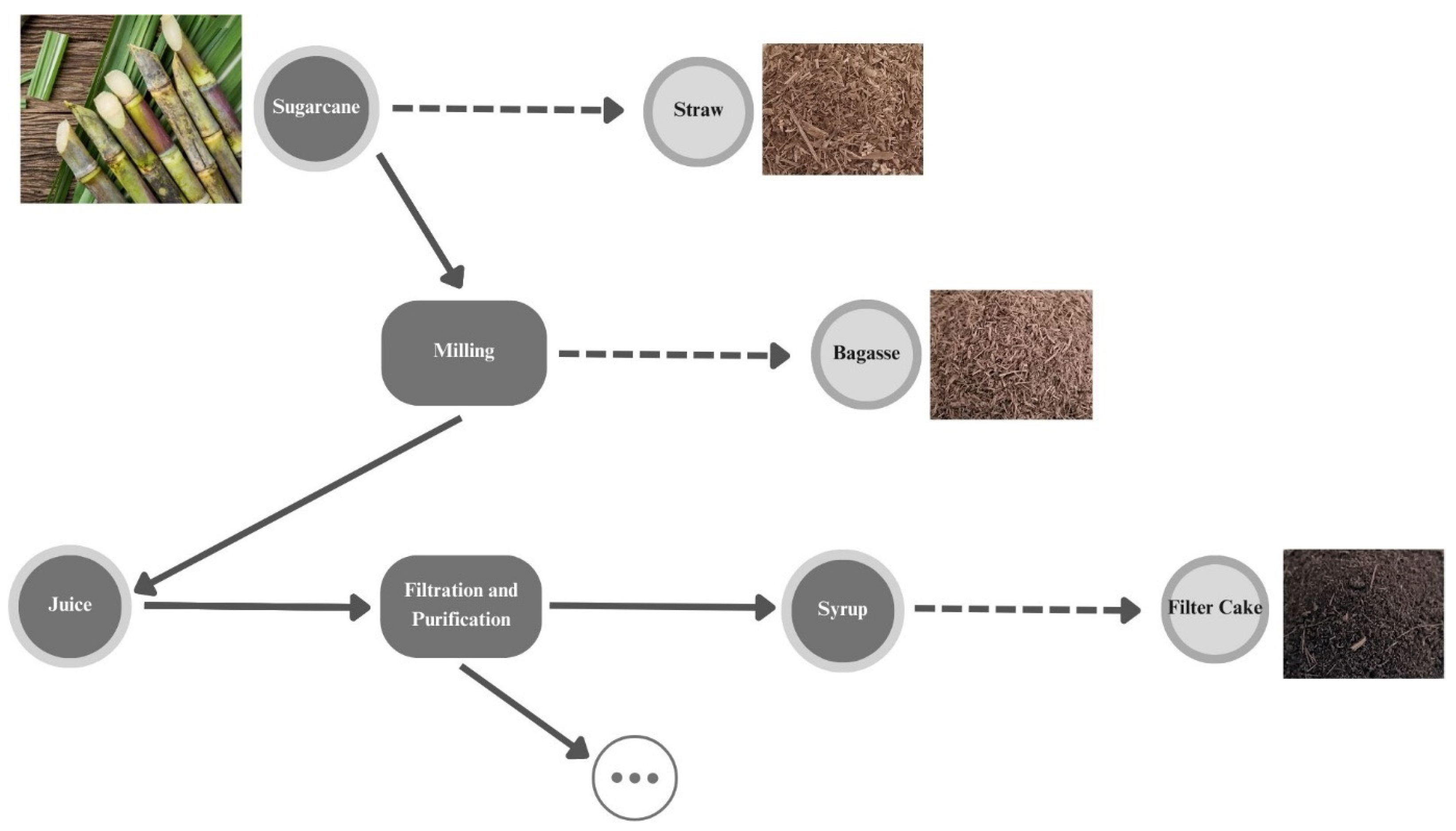
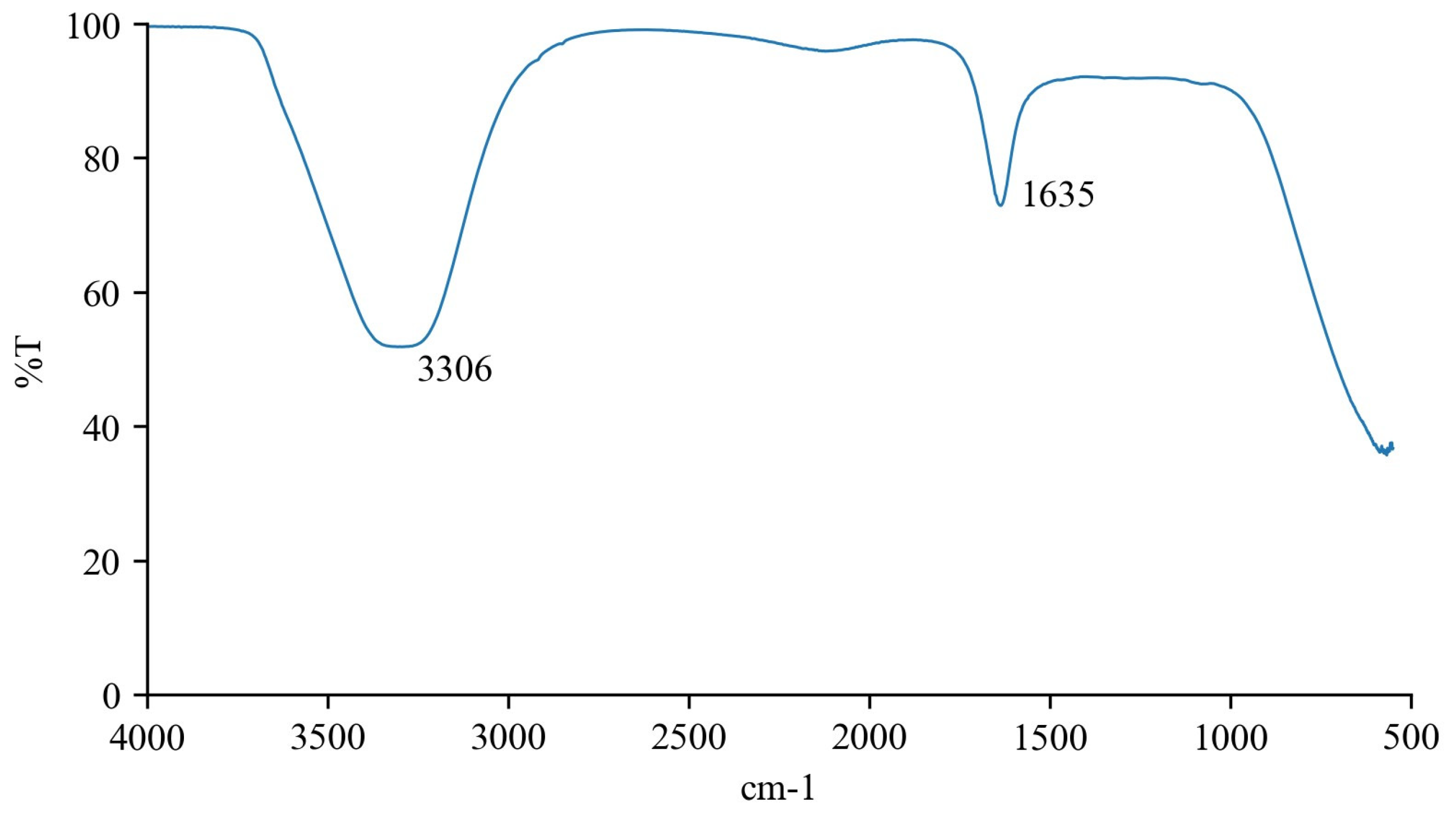

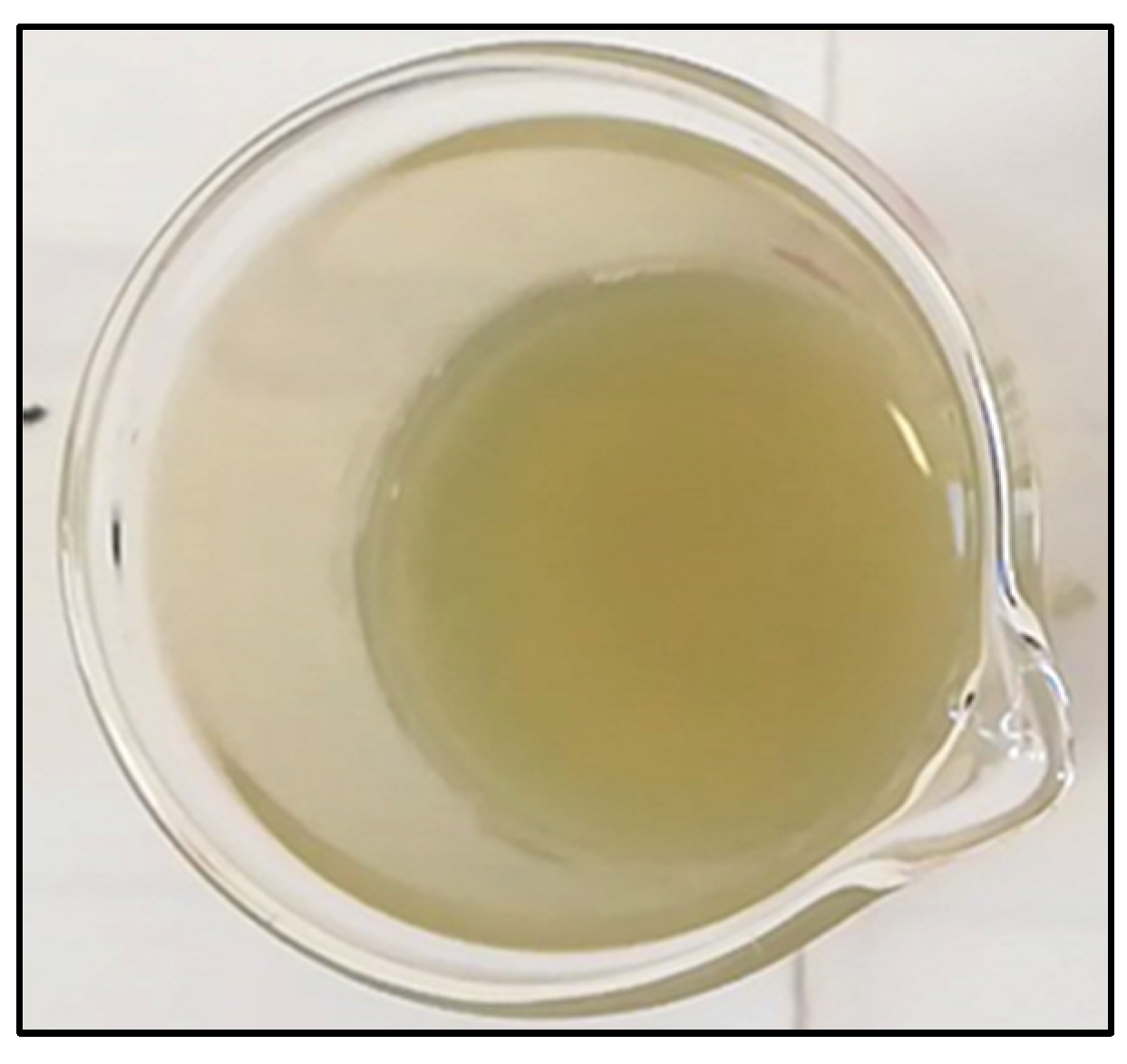
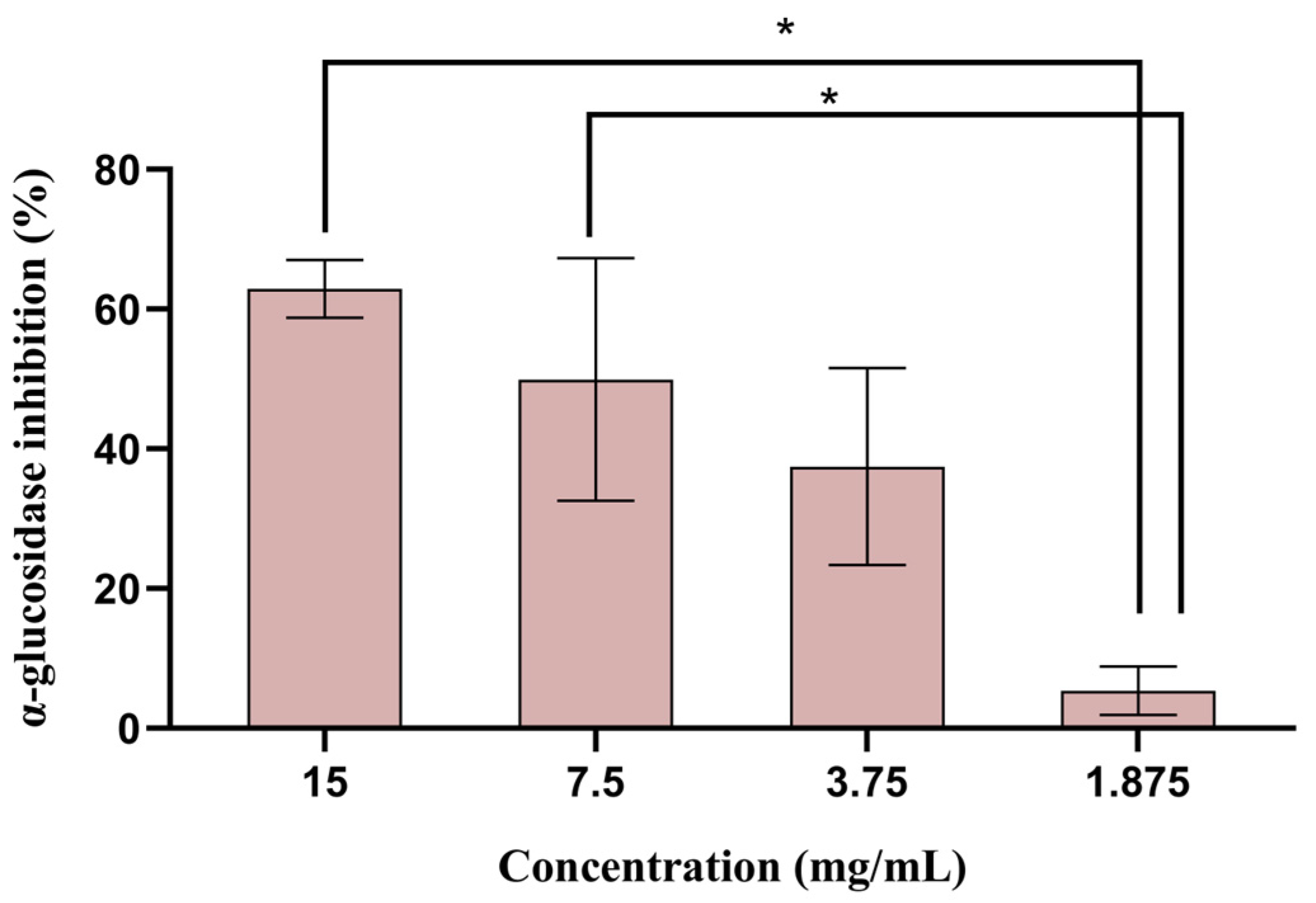
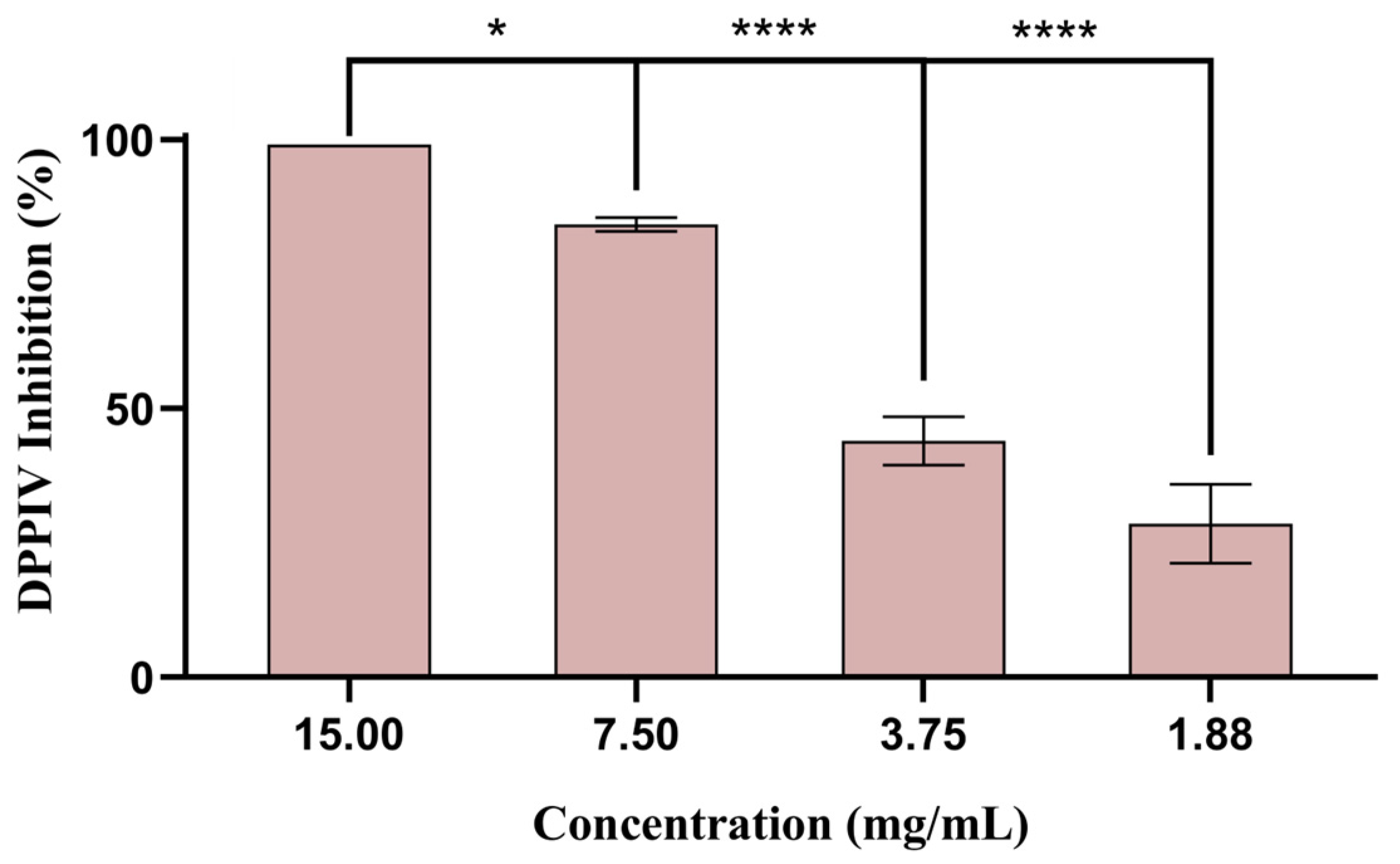
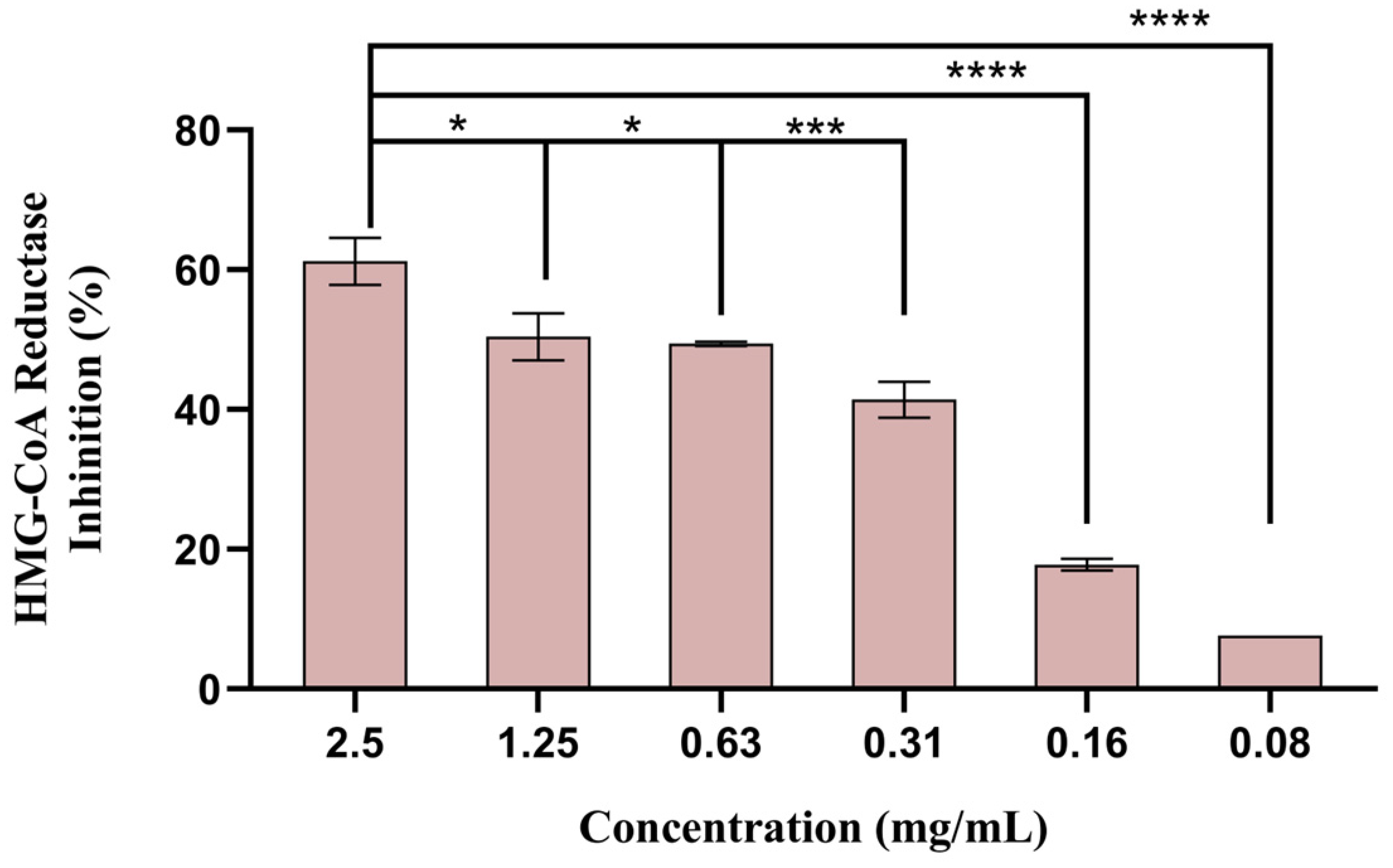

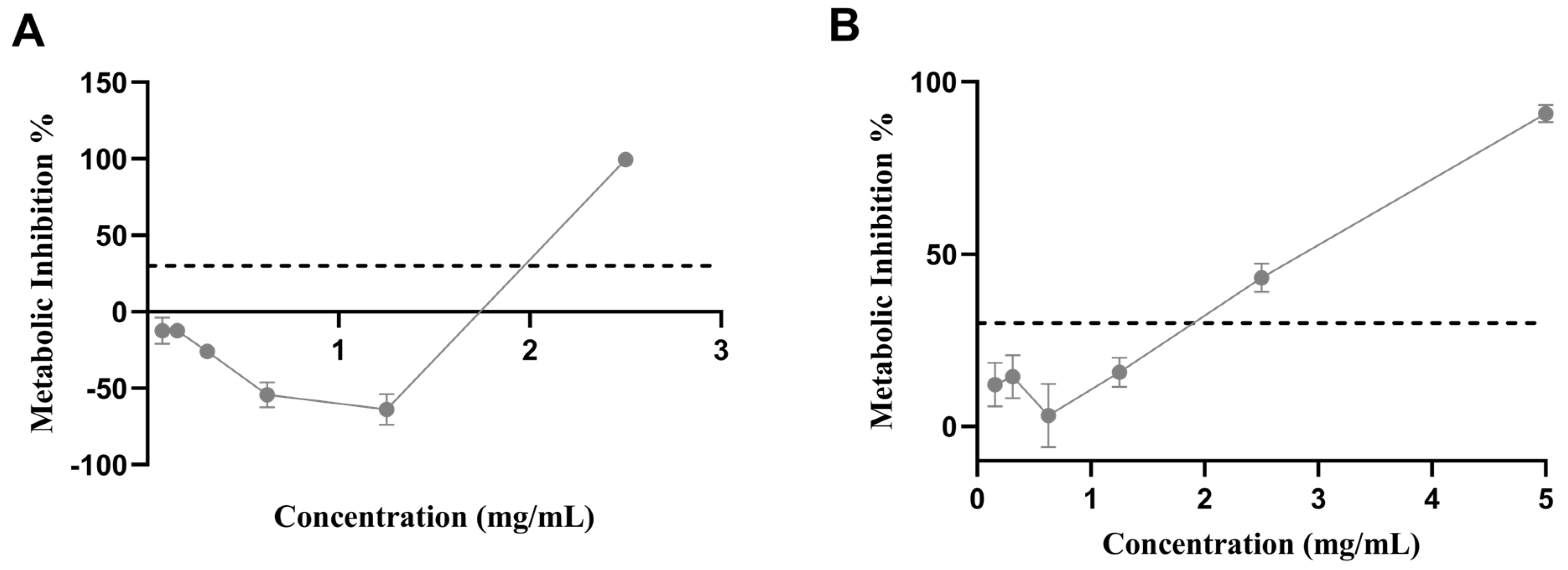
| Sugarcane Byproduct Extract (g/kg) | |
|---|---|
| 2,3-Butanediol | 0.29 ± 0.04 |
| Acetin | 1.23 ± 0.08 |
| Glycerol | 4.60 ± 0.57 |
| 1,2,3-Butanetriol | 0.36 ± 0.03 |
| Ribitol | 0.17 ± 0.05 |
| ΣAlcohol | 6.66 ± 0.62 |
| Palmitic acid | 11.96 ± 0.39 |
| Linoleic acid | 1.86 ± 0.15 |
| Oleic acid | 4.65 ± 0.31 |
| Stearic acid | 3.63 ± 0.41 |
| Arachidic acid | 0.62 ± 0.04 |
| Lignoceric acid | 0.97 ± 0.12 |
| Octacosanoic acid | 6.75 ± 1.09 |
| Triacontanoic acid | 1.79 ± 0.39 |
| ΣFree fatty acid | 32.23 ± 2.05 |
| 1-Hexacosanol | 2.22 ± 0.17 |
| 1-Octacosanol | 18.10 ± 2.19 |
| 1-Triacontanol | 4.07 ± 0.46 |
| 1-Dotriacontanol | 2.86 ± 0.35 |
| ΣFatty alcohol | 27.25 ± 3.14 |
| Heptacosane | 1.80 ± 0.10 |
| Nonacosane | 0.65 ± 0.04 |
| ΣHydrocarbon | 2.45 ± 0.13 |
| Lactic acid | 3.35 ± 0.07 |
| β-Hydroxypyruvic acid | 0.31 ± 0.05 |
| ΣOrganic acid | 3.66 ± 0.11 |
| Campesterol | 4.06 ± 0.37 |
| Stigmasterol | 6.25 ± 0.56 |
| β-Sitosterol | 9.45 ± 0.67 |
| Stigmast-4-en-3-one | 0.81 ± 0.10 |
| ΣPhytosterols | 20.56 ± 1.69 |
| ΣSugars | 8.86 ± 2.41 |
| Octacosanal | 3.38 ± 0.34 |
| (E)-9-Octadecenoic acid ethyl ester | 0.71 ± 0.06 |
| 4-Coumaric acid | 2.83 ± 0.26 |
Disclaimer/Publisher’s Note: The statements, opinions and data contained in all publications are solely those of the individual author(s) and contributor(s) and not of MDPI and/or the editor(s). MDPI and/or the editor(s) disclaim responsibility for any injury to people or property resulting from any ideas, methods, instructions or products referred to in the content. |
© 2024 by the authors. Licensee MDPI, Basel, Switzerland. This article is an open access article distributed under the terms and conditions of the Creative Commons Attribution (CC BY) license (https://creativecommons.org/licenses/by/4.0/).
Share and Cite
Pereira, J.O.; Oliveira, D.; Faustino, M.; Vidigal, S.S.M.P.; Pereira, A.M.; Ferreira, C.M.H.; Oliveira, A.S.; Durão, J.; Rodríguez-Alcalá, L.M.; Pintado, M.E.; et al. Use of Various Sugarcane Byproducts to Produce Lipid Extracts with Bioactive Properties: Physicochemical and Biological Characterization. Biomolecules 2024, 14, 233. https://doi.org/10.3390/biom14020233
Pereira JO, Oliveira D, Faustino M, Vidigal SSMP, Pereira AM, Ferreira CMH, Oliveira AS, Durão J, Rodríguez-Alcalá LM, Pintado ME, et al. Use of Various Sugarcane Byproducts to Produce Lipid Extracts with Bioactive Properties: Physicochemical and Biological Characterization. Biomolecules. 2024; 14(2):233. https://doi.org/10.3390/biom14020233
Chicago/Turabian StylePereira, Joana Odila, Diana Oliveira, Margarida Faustino, Susana S. M. P. Vidigal, Ana Margarida Pereira, Carlos M. H. Ferreira, Ana Sofia Oliveira, Joana Durão, Luís M. Rodríguez-Alcalá, Manuela E. Pintado, and et al. 2024. "Use of Various Sugarcane Byproducts to Produce Lipid Extracts with Bioactive Properties: Physicochemical and Biological Characterization" Biomolecules 14, no. 2: 233. https://doi.org/10.3390/biom14020233
APA StylePereira, J. O., Oliveira, D., Faustino, M., Vidigal, S. S. M. P., Pereira, A. M., Ferreira, C. M. H., Oliveira, A. S., Durão, J., Rodríguez-Alcalá, L. M., Pintado, M. E., Madureira, A. R., & Carvalho, A. P. (2024). Use of Various Sugarcane Byproducts to Produce Lipid Extracts with Bioactive Properties: Physicochemical and Biological Characterization. Biomolecules, 14(2), 233. https://doi.org/10.3390/biom14020233










